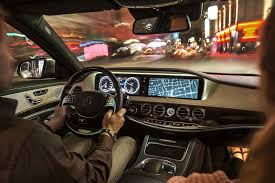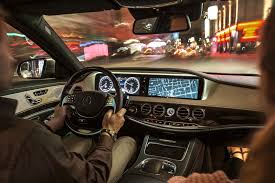
Up till now the car market has operated on the principle that bigger is better. However the rapidly evolving technology is upending the traditional pecking order in the luxury car market.
At present a host of car makers are quietly changing the rules.
There will be better computer chips, cameras, software and sensors than those in the larger and more expensive S-Class in the Mercedes' new E-Class mid-sized sedan that was unveiled at the Detroit auto show on Monday.
The S-Class is the flagship that has for decades showcased the automaker's latest technology.
"The speed of innovation is so fast that you have to use every launch of a new model to roll stuff out," Dieter Zetsche, head of Mercedes-Benz Cars said to the media on the sidelines of an event to launch the new E-Class at the Detroit Auto Show.
In order to compete for the younger customers, the car makers have been forced to accept the shift as they relent to the intense pressure to keep their model lineups on the technological edge. This also indicates another sign where features in cars that can be updated with software - a tactic used often by Silicon Valley electric car maker Tesla Motors and is most likely to be followed across the industry.
Through the use of digital prototypes, Mercedes has cut the time it takes to produce a prototype to 10 months from 18 months and plans similar software updates as it moves aggressively to update its hardware as well. Cutting development time in a wind tunnel, for example, aerodynamic testing is done largely with simulation software.
Executives at Daimler, parent company of Mercedes-Benz, explained in Detroit said that the E-Class has fourth-generation driver assistance systems, while the top-of-the-line S-Class makes do with third-generation technology.
Giving the vehicle a better ability to interpret its surroundings, more recent sensors and software give the new E-Class better algorithms to recognise a street, a vehicle or a pedestrian. This in turn allows the Mercedes to travel greater distances in self-driving mode.
Allowing the car to exchange information with vehicles ahead to receive warnings about potential accidents or broken down vehicles ahead, it also has car-to-car communications technology.
These capabilities are not present in the current S-Class model, which has been in showrooms since 2013.
With the earliest feasible model debut, Mercedes plans to continue the strategy of introducing its latest breakthroughs. Other automakers may well follow suit.
"The best features were always introduced into the highest end vehicles. That is not going to be the best solution for the car industry anymore. Younger customers want the latest features immediately, and this will force carmakers to change their offerings, and it will change the way they define premium," said Thilo Koslowski, vice president of the automotive practice at technology market research firm Gartner.
Mercedes-Benz already introduced its Collision Prevent Assist Plus into the compact B-Class before it spread it to larger vehicles.
While accepting the move by the company is to steal customers from Audi and BMW, Zetsche acknowledged that the shift could also cause some would-be S-class buyers to migrate to the less expensive E-class.
"We are interested in external conquest," Zetsche said.
(Source:www.khaleejtimes.com)
At present a host of car makers are quietly changing the rules.
There will be better computer chips, cameras, software and sensors than those in the larger and more expensive S-Class in the Mercedes' new E-Class mid-sized sedan that was unveiled at the Detroit auto show on Monday.
The S-Class is the flagship that has for decades showcased the automaker's latest technology.
"The speed of innovation is so fast that you have to use every launch of a new model to roll stuff out," Dieter Zetsche, head of Mercedes-Benz Cars said to the media on the sidelines of an event to launch the new E-Class at the Detroit Auto Show.
In order to compete for the younger customers, the car makers have been forced to accept the shift as they relent to the intense pressure to keep their model lineups on the technological edge. This also indicates another sign where features in cars that can be updated with software - a tactic used often by Silicon Valley electric car maker Tesla Motors and is most likely to be followed across the industry.
Through the use of digital prototypes, Mercedes has cut the time it takes to produce a prototype to 10 months from 18 months and plans similar software updates as it moves aggressively to update its hardware as well. Cutting development time in a wind tunnel, for example, aerodynamic testing is done largely with simulation software.
Executives at Daimler, parent company of Mercedes-Benz, explained in Detroit said that the E-Class has fourth-generation driver assistance systems, while the top-of-the-line S-Class makes do with third-generation technology.
Giving the vehicle a better ability to interpret its surroundings, more recent sensors and software give the new E-Class better algorithms to recognise a street, a vehicle or a pedestrian. This in turn allows the Mercedes to travel greater distances in self-driving mode.
Allowing the car to exchange information with vehicles ahead to receive warnings about potential accidents or broken down vehicles ahead, it also has car-to-car communications technology.
These capabilities are not present in the current S-Class model, which has been in showrooms since 2013.
With the earliest feasible model debut, Mercedes plans to continue the strategy of introducing its latest breakthroughs. Other automakers may well follow suit.
"The best features were always introduced into the highest end vehicles. That is not going to be the best solution for the car industry anymore. Younger customers want the latest features immediately, and this will force carmakers to change their offerings, and it will change the way they define premium," said Thilo Koslowski, vice president of the automotive practice at technology market research firm Gartner.
Mercedes-Benz already introduced its Collision Prevent Assist Plus into the compact B-Class before it spread it to larger vehicles.
While accepting the move by the company is to steal customers from Audi and BMW, Zetsche acknowledged that the shift could also cause some would-be S-class buyers to migrate to the less expensive E-class.
"We are interested in external conquest," Zetsche said.
(Source:www.khaleejtimes.com)





